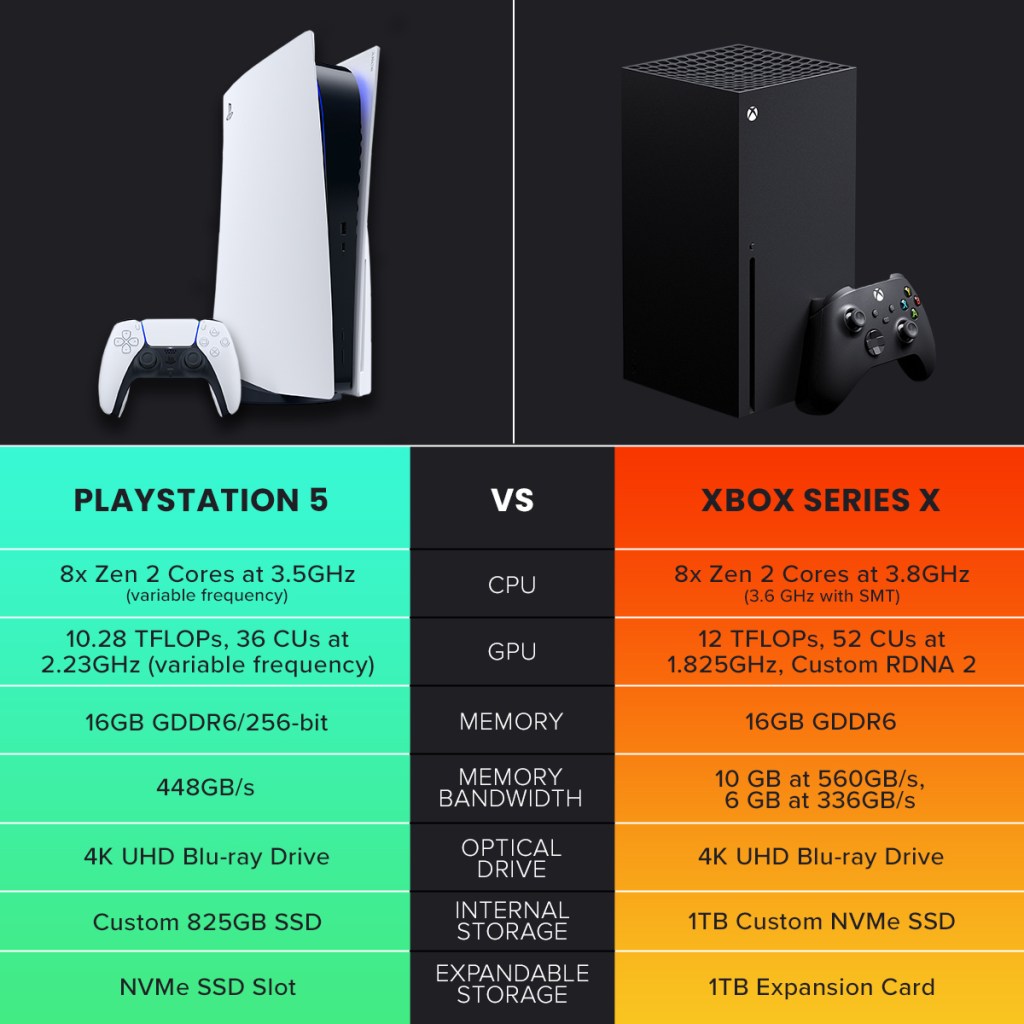PlayStation 5 vs. Xbox Series X: A Deep Dive Comparison of the Next-Gen Consoles
Hardware Specifications and Performance
The Xbox Series X is touted as being the more powerful console based on its rumored 12 teraflops of graphics processing power and 3.8 GHz AMD Zen 2 CPU. While the PS5’s GPU is reported to be around 10.28 teraflops, its custom AMD CPU may help maximize performance. Both consoles support 4K graphics and up to 120 frames per second for supported games. A major differentiator is the PS5’s custom 825GB SSD storage. Its unprecedented speeds of 5.5GB/s for raw data and up to 9GB/s with game asset compression could help eliminate load times and enable new gameplay possibilities. The Series X has a 1TB NVMe SSD but with slower bandwidth around 2.4GB/s. This SSD advantage may give the PS5 an edge with exclusives optimized for its technology.

Exclusive Game Libraries
Sony has cultivated strong relationships with developers like Naughty Dog, Insomniac, and Guerrilla Games to deliver renowned exclusive franchises like Uncharted, Spider-Man, Horizon Zero Dawn. With highly anticipated sequels in the works, the PS5 may continue this trend on launch. However, Microsoft’s acquisition of ZeniMax Media gives them ownership of blockbuster series like The Elder Scrolls, Fallout, and Doom. Along with purchases of Obsidian and Double Fine, their Xbox Game Studios is growing to directly challenge Sony’s lineup. It will be interesting to see which company delivers a breadth of new exclusive experiences at launch and beyond.
Subscription Services and Value
Xbox Game Pass offers an expansive library of over 100 games for a low monthly fee. As a growing service, more Day One launches and legacy titles are joining all the time. This massive game catalog provides great value for new Xbox users and may attract some PlayStation fans. While PlayStation Now allows streaming older games, it lacks Game Pass’s convenience and modern titles. However, we don’t know Sony’s plans for the PS5. If a similar service with new releases is offered at a competitive price, it could match Game Pass’s appeal. Pricing for the consoles themselves will also impact purchases, favoring whoever offers the best value.
Backwards Compatibility and Legacy Content
Both systems are compatible with recent generations, though Xbox goes even further back. The PS5 plays PS4 games while Xbox Series X supports titles from the original Xbox, Xbox 360 and Xbox One. This gives Xbox an immediate advantage in legacy content available at launch. However, only a portion of older games may see significant improvements or utilize the new consoles’ full capabilities. The rest may simply be emulated rather than true remasters. For those without huge back catalogs, the focus will be on new next-gen exclusives and experiences.
Controller Innovations
Building on the success of their DualShock and Xbox controllers, Sony and Microsoft are adding new immersive features. The PS5’s DualSense introduces haptic feedback and adaptive trigger technology to simulate different textures and resistances. This could elevate gaming to a more tactile experience. Xbox’s new controller also refines their design with a improved D-pad, hybrid battery compartment, and compatibility with Bluetooth and wireless connections. Its haptics and triggers seem less refined than Sony’s from early previews, but we’ll have to wait for hands-on time to judge. Both controllers aim to bring new layers of immersion.
Online Services at Launch
While Xbox Game Pass is an enticing bargain already, online services plans for PS5 remain shrouded in mystery. Details on subscription pricing, cloud saves, party features, and the quality of PS Now streaming on next-gen hardware are unknowns. Microsoft has an early service lead but Sony could regain ground with competitive perks. Availability of digital games, pre-load windows for physical discs, and download/install speeds may also influence early adoption. Fast onboarding experiences onto the platforms could drive momentum, especially important for the holiday 2020 launches amid the pandemic’s ongoing impact on retail. Sony has some catching up to do in services transparency right now.
Thermal Design and Engineering
The Xbox Series X takes a conventional vertical tower approach to heat dissipation versus Sony’s unusual curved, sloped casing. Only time and testing will reveal if the PS5 design successfully handles the substantial thermal load within its compact frame. Overheating could undermine sustained performance or even potentially reduce the console’s lifespan. That said, Sony is no stranger to consumer electronics thermal engineering challenges. If implemented properly, their futuristic aesthetic could be an exciting differentiator. But questions persist until real-world durability is proven. For now, Xbox has the less complicated cooling infrastructure according to spec sheet analyses. In conclusion, both consoles represent significant generational leaps. While the Series X has a theoretical raw power edge, the PS5’s speedy SSD could enable groundbreaking new gameplay. Exclusive games and subscription value propositions will be major purchase drivers as the brands enter the next generation this holiday season.